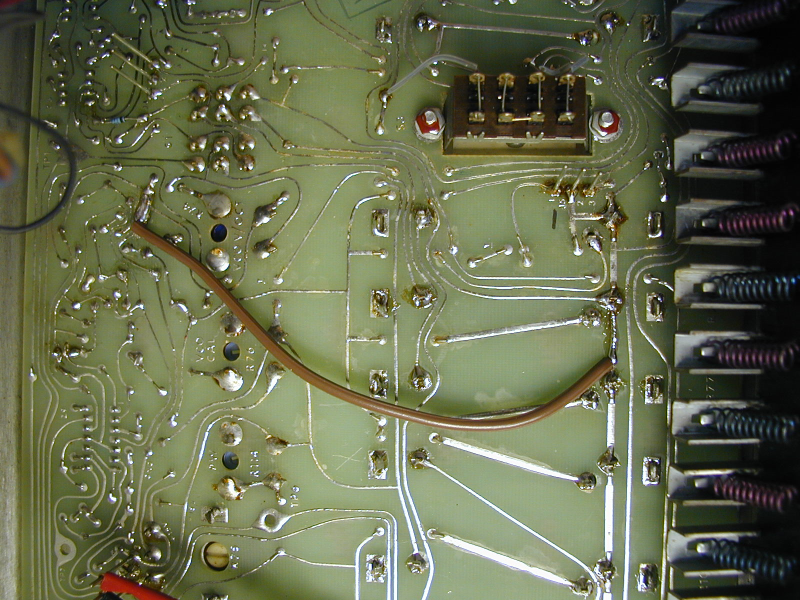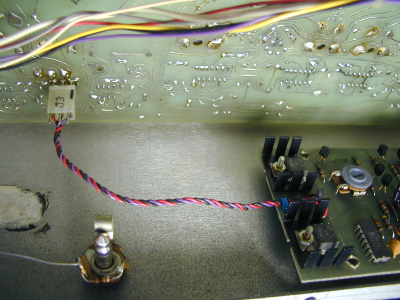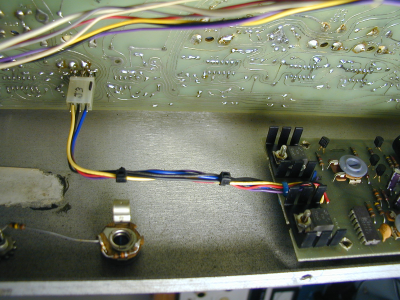A couple of Small Modifications to my ARP Axxe (To cure two minor issues)
About six months ago I was helping a friend repair his ARP Axxe, and while we were working on it, he noticed that the pitch changed a little bit when a key was pressed. When the key was released, the pitch dropped just enough to be noticeable (and annoying). I spent a few hours tracking this down, and ended up curing it by adding a heavy wire to connect Gnd in two places on the PCB. But I didn't take any notes on what I had done or which model it was. Just a few weeks ago, I bought an Axxe (2810) on a popular auction sight. After I got it pretty much working, I discovered that it had the same exact issue that we had fixed before. So I added an AWG 18 wire to the back of the PCB, after measuring the DC voltage at several different Gnd points with a key pressed and released. Before I added the wire, I had roughly 0.8 mV shift between the two gnds when a key was pressed. That isn't much, but it doesn't take much to shift the pitch of the VCO. With the wire, there is still a very very slight pitch shift, but it is probably nothing that anyone would every notice. Here is a photo that shows where the wire was added:

As I was testing my Axxe, I noticed that even with the VCO mod sliders all the way down, I could still here the frequency of the LFO in the output signal. It was very faint, but easy to hear if you listened for it. I could adjust the LFO rate and hear it changing. At first I figured this was caused by the mod pot wipers not going all the way to 0 ohms, but tried shorting the wipers to gnd at the pots, and heard no change. On my unit, the wires from the power supply to the main board connector were about twice as long as they needed to be. Maybe they left them that way to ease servicing. The Axxe does not use remote sensing to regulate at the pc bd end the way the Omni P/S does. So any resistance in these wires will cause the voltage to change with changes in current. I removed about half the length of the wires, and noticed that the LFO rate was harder to hear on the main output with mod disabled, but was still audible. So I connected my bench power supply instead of the ARP one (with nice thick leads), and was no longer able to hear the LFO rate. I determined that it was the -15V supply that was causing the very slight pitch shift as the LFO toggled. Then I measured the -15V current for both states of the LFO. It was roughly 24.6mA and 25.6 mA. The -15V was changing about 4mV at the LFO rate, which I slowed down to let the meter settle. I added a clip-lead from -15V at the supply to the -15V pin on the main bd and the pitch change disappeared. So I decided to beef up the wires between the P/S and the connector, by doubling up on them, since larger wire would have required drilling out the holes. My ARP P/S already had three holes drilled for each signal. I removed the twists in the wire, since this is DC and there is no need for it, and it just adds length/resistance. Note that one of the +15V P/S pcb holes is pretty close to one of the heat sinks, so be careful not to let that wire touch the heat sink. Here are some pictures showing the original ARP wires after I shortened them, and with my new wires added.


Note: My unit is 2810 number 566. It's possible that later units/models of the Axxe had changes to address one or both of these issues. You can easily check for both effects without taking the Axxe apart.
DISCLAIMER: I take no responsibility whatsoever for the use and/or implementation thereof, or the misuse leading to damage to equipment, property, or life, caused by the above circuits.